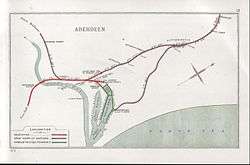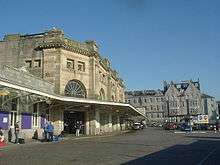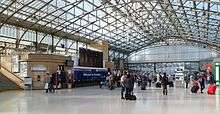Aberdeen railway station
Aberdeen railway station is the only railway station in Aberdeen, Scotland. It is the busiest railway station in Scotland north of the major cities of Glasgow and Edinburgh. It is located on Guild Street in the city centre, next to Union Square.
| Aberdeen | |
|---|---|
| Scottish Gaelic: Obar Dheathain[1] | |
Concourse at Aberdeen station | |
| Location | |
| Place | Aberdeen |
| Local authority | City of Aberdeen |
| Coordinates | 57.1436°N 2.0985°W |
| Grid reference | NJ941058 |
| Operations | |
| Station code | ABD |
| Managed by | Abellio ScotRail |
| Number of platforms | 5 (numbered 3–7) |
| Live arrivals/departures, station information and onward connections from National Rail Enquiries | |
| Annual rail passenger usage* | |
| 2014/15 | |
| – Interchange | |
| 2015/16 | |
| – Interchange | |
| 2016/17 | |
| – Interchange | |
| 2017/18 | |
| – Interchange | |
| 2018/19 | |
| – Interchange | |
| History | |
| Original company | Denburn Valley Line |
| Pre-grouping | CR & GNoSR |
| Post-grouping | LMS & LNER |
| 4 November 1867 | Station opened as Aberdeen Joint to replace Aberdeen Guild Street and Aberdeen Waterloo[2] |
| 1913–1916 | Rebuilt |
| 1952 | Renamed Aberdeen[2] |
| 2007–2008 | Major refurbishment |
| Listed status | |
| Listing grade | Category A |
| Entry number | LB20673[3] |
| Added to list | 2 March 1990 |
| National Rail – UK railway stations | |
| * Annual estimated passenger usage based on sales of tickets in stated financial year(s) which end or originate at Aberdeen from Office of Rail and Road statistics. Methodology may vary year on year. | |
The station is managed by Abellio ScotRail. Inter-city, regional, local and sleeper train services are provided to all parts of Great Britain by Abellio ScotRail, Caledonian Sleeper, CrossCountry and London North Eastern Railway. The station is the northern terminus of the Dundee–Aberdeen line and the southern terminus of the Aberdeen–Inverness line.
History

Pre-nationalisation
The station currently standing was built as Aberdeen Joint Station between 1913 and 1916, replacing an 1867 structure of the same name, on the same site. The station and the new Denburn Valley Line enabled the main line from the south and the commuter line from Deeside to connect with the line from the north. The lines from the south had previously terminated at the adjacent Aberdeen Guild Street. Even this had not been Aberdeen's first railway station, that distinction belonging to a previous terminus a short way south at Ferryhill. After the construction of the Joint Station, Guild Street Station became a goods station. Some of its tracks remain, but the vast majority of the site was cleared in 2005.
Prior to the construction of the Joint Station, lines from the north had terminated at Aberdeen Waterloo, a short but inconvenient distance along the edge of the harbour. This too became a goods station after the construction of the Joint Station. There is no longer a station at the site, but a goods service runs approximately weekly to industrial operations there. The Waterloo tracks join the north–south connecting Denburn Valley Line in the Kittybrewster area of the city, where the very first terminus of the lines from the north had briefly been, before extension and the building of the Waterloo Station. As far north as Inverurie, these follow the route of the Aberdeenshire Canal which had been purchased and filled in by the Great North of Scotland Railway.
Nationalisation and privatisation

As a result of the grouping of railway companies under the Railways Act 1921, Aberdeen was shared by the London and North Eastern Railway and the London Midland and Scottish Railway, each company running the station for a year and then handing its administration to the other company. At nationalisation in 1948, it then became part of British Rail. As part of the changes during this period which saw a general contraction of railway services in the UK, some services were cut in the 1960s. These included those running north to Peterhead and Ellon as well as the Deeside Line. Suburban services were heavily reduced and the grand suburban ticket office, located on the corner of Guild Street and Bridge Street, was closed. It now houses a hair and beauty salon. The number of platforms at the station were also reduced considerably in the early 1970s, from the thirteen of the late 1950s/early 1960s down to just seven by 1973.[4] This rationalisation process saw the removal of all of the north end bay platforms to allow for redevelopment of that part of the site. However, significant improvements under British Rail included introduction of InterCity 125 high-speed service to London and other major destinations, and introduction of other new rolling stock. Other improvements included a new Travel Centre opened in 1978 and under British Rail's regional brand ScotRail, a major station renovation was completed in the 1980s. The station was also resignalled around this time, with two more bay platforms (1 & 2) taken out of use along with the former through platforms 8 & 9. This left just five platforms (3–7) in regular use – the layout that remains in operation to this day. The two former bay platforms remain in place and are used as sidings. The former double track through platforms 8 and 9 has since been singled, but the platform faces remain.
At privatisation in the mid-1990s, ownership of the station passed to Railtrack (along with all stations and other infrastructure in England, Wales and Scotland), while day-to-day management passed to the train-operating franchisee ScotRail, a division of National Express. Following the quasi-nationalisation of railway infrastructure in the early 2000s, the station is now owned by Network Rail. In 2004, the train-operating franchise and station management were taken over by First ScotRail. ScotRail continue to operate trains but the station and all signage is now branded with the "ScotRail" logo, typeface and rolling-stock livery.

Listed building
Historic Environment Scotland designate the current building and road overbridge as Category A, noting that it was the last major station to be completed in Scotland in the period 1913 - 20.[3]
Redevelopment as part of Union Square
The station had gradually become run-down in the last years of British Rail. In the late 2000s, the railway station and bus station were included in the extensive Union Square development, primarily sited on an abandoned railway goods yard east of the station. As part of this, the railway station was comprehensively refurbished. The original sandstone station building became the centrepiece of a covered plaza for the new shopping and entertainment complex, while a granite-faced building was constructed to house station offices, a new Travel Centre, and other facilities. The car park at the front of the station was replaced by a public square providing pedestrian access to the station and Union Square. In addition, direct access was provided from the station concourse to Union Square and through to the bus station, creating a completely covered transport interchange. The refurbished station opened in 2009 followed by Union Square itself some months later.
Future developments
Plans to relocate the ticket office and passenger waiting room, as well as upgrades to the taxi rank and concourse, were approved by Aberdeen City Council in December 2018, with work due to start in spring 2019.[5] Under a separate scheme, the vacant Atholl House building to the north of the station is to be demolished, making way for the construction of a public square, hotel and student accommodation, and improved connections between the city's main Union Street and the station.[6] This development could allow the currently disused platforms 8 and 9 to be brought back into service.[7]
As of early 2019, the station's glass roof is undergoing replacement with polycarbonate panels as part of a £9 million upgrade.[8] In June 2020, ScotRail announced that it would proceed with the modifications to the ticket office, waiting room, and taxi rank as soon as it was safe to do so following the coronavirus pandemic. There are no plans to reinstate the platforms yet.[9]
Station services

Passenger facilities
There is a staffed travel centre providing ticket office and information facilities (e.g. timetables), although it is not open in the late evening and closes before the last trains have departed. There are also automatic ticket machines outside this office and in the main concourse. Tickets purchased in advance (e.g. on the internet) can be collected from any of these machines. The entrance to the ScotRail first-class lounge is located inside the ticket office. Luggage trolleys are provided for travellers with baggage and a left-luggage facility is available with access from the front forecourt of the station.
A waiting room is available on the main concourse, as is a branch of WHSmith selling books, magazines, stationery and confectionery. There is also a pub and café. A wide range of other shopping and eating facilities are located in the Union Square complex which can be accessed directly through the concourse and is integrated with the station building. These include Boots, Costa Coffee, Starbucks, Marks & Spencer Simply Food and a range of other shops and restaurants. Unlike the travel centre, facilities at Union Square open late into the evening and also include ATM machines, through-access to the city's bus station, and a hotel operated by Jurys Inn. The original Station Hotel (now privately operated) as formerly operated by the Great North of Scotland Railway is open and located on Guild Street directly opposite the station.
There are toilet facilities accessible from the concourse, in addition to toilet facilities in the café (free to customers), on most trains (free to passengers) and in Union Square.
Parking and onward transport
Medium-term parking is available in the adjoining College Street Car Park (with access only from College Street) and there are also a small number of free spaces which offer parking for 20 minutes only in a separate section of the car park inside the station itself. Taxis are available from a stand within the station concourse.
Regional and national bus services (including buses to Aberdeen Airport) depart from Aberdeen bus station, which is located on the other side of the adjoining Union Square shopping and entertainment complex. It is possible to walk directly from the concourse, through Union Square and to the bus station without entering the open air. This option is useful in winter and in periods of bad weather.
Rail services and train operators
Automated ticket barriers operate at all platforms but are left open when staff are not present. All scheduled services are operated by diesel-powered rolling stock. The services from Aberdeen for the Summer 2016 timetable (from 15 May 2016) are:
ScotRail

- 1tph to Edinburgh Waverley via Dundee operated by Class 158 Express Sprinter units or Class 170 Turbostar units.
- 1tph to Glasgow Queen Street via Dundee, Perth and Stirling (Scotland) operated by Class 158 Express Sprinter units or Class 170 Turbostar units where 1tpd starts at Inverurie via Aberdeen.
- 2tph to Inverurie via Dyce, of which 1tp2h continues to Inverness via Keith and Elgin operated by Class 158 Express Sprinter units or Class 170 Turbostar units.[10]
CrossCountry
- 1tpd to Penzance, along the Cross Country Route via Dundee, Edinburgh Waverley, Newcastle, York, Leeds, Sheffield, Derby, Birmingham New Street, Bristol Temple Meads, Exeter St Davids and Plymouth. These services are operated by Class 220 Voyager units, Class 221 Super Voyager units or by one of CrossCountry's InterCity 125 sets. This service is the longest train service in the United Kingdom, with a length of 1,162 kilometres (722 mi) and a duration of 13 hrs 23 mins.
- 1tpd to Edinburgh Waverley via Dundee and Haymarket.[12]
London North Eastern Railway
- 3tpd to London King's Cross via Dundee, Edinburgh Waverley, Newcastle and York. These services are operated by Class 800 bi-mode multiple units.
- 1tpd to Leeds via Dundee, Edinburgh Waverley, Newcastle and York. This service is operated by Class 800 bi-mode multiple units.[13]
Ferry Services
Aberdeen railway station offers interchange with Aberdeen ferry terminal, which lies approximately 450 metres (0.28 mi) away, the departure point for ferry services to the Orkney and Shetland Islands. The ferries, operated by NorthLink Ferries, include a daily direct sailing to Lerwick, Shetland lasting around 12 hours overnight. On certain days of the week, the Lerwick ferry crossing includes a call at Kirkwall on Orkney, increasing the journey time by 2 hours.
Future service improvements
Service frequencies are to be improved here from 2018 as part of a major timetable recast funded by Transport Scotland. A new Aberdeen Crossrail commuter service is to be introduced between Montrose and Inverurie, which will call here and the other intermediate stations en route once per hour in each direction.[14] The existing hourly services to Edinburgh & Glasgow will be accelerated and use refurbished HST sets rather than the existing DMUs, whilst the line as far as Inverurie will have a half-hourly frequency throughout the day. A £170 million upgrade project for the line to Inverness will see that section doubled by the end of 2019, signalling & level crossings on the route modernised and the stations at Kintore and Dalcross reopened.[15]
| Railway stations around Aberdeen | ||||||||||||||||||||||||||||||||||||||||||||||||||||||||||||||||||||||||||||||||||||||||||||||||||||||||||||||||||||
|---|---|---|---|---|---|---|---|---|---|---|---|---|---|---|---|---|---|---|---|---|---|---|---|---|---|---|---|---|---|---|---|---|---|---|---|---|---|---|---|---|---|---|---|---|---|---|---|---|---|---|---|---|---|---|---|---|---|---|---|---|---|---|---|---|---|---|---|---|---|---|---|---|---|---|---|---|---|---|---|---|---|---|---|---|---|---|---|---|---|---|---|---|---|---|---|---|---|---|---|---|---|---|---|---|---|---|---|---|---|---|---|---|---|---|---|---|
| ||||||||||||||||||||||||||||||||||||||||||||||||||||||||||||||||||||||||||||||||||||||||||||||||||||||||||||||||||||
| ||||||||||||||||||||||||||||||||||||||||||||||||||||||||||||||||||||||||||||||||||||||||||||||||||||||||||||||||||||
| Preceding station | Following station | |||
|---|---|---|---|---|
| Stonehaven | CrossCountry Cross Country Network |
Terminus | ||
| Portlethen | Abellio ScotRail Edinburgh to Aberdeen Line |
Dyce | ||
| Portlethen | Abellio ScotRail Glasgow to Aberdeen Line |
Terminus | ||
| Terminus | Abellio ScotRail Aberdeen to Inverness Line |
Dyce | ||
| Stonehaven | Caledonian Sleeper Caledonian Sleeper |
Terminus | ||
| Stonehaven | London North Eastern Railway East Coast Main Line |
Terminus | ||
| Terminus | NorthLink Ferries Shetland ferry service |
Lerwick | ||
| Terminus | NorthLink Ferries Orkney ferry service |
Kirkwall | ||
| Historical railways | ||||
| Cove Bay Line open; Station closed |
Caledonian Railway Aberdeen Railway |
Terminus | ||
| Holburn Street Line and Station closed |
Great North of Scotland Railway Deeside Railway |
Terminus | ||
| Terminus | GNoSR / CR Joint Denburn Valley Line |
Schoolhill Line open; Station closed | ||
See also
References
Notes
| Wikimedia Commons has media related to Aberdeen railway station. |
- Brailsford 2017, Gaelic/English Station Index.
- Butt (1995), page 12
- Historic Environment Scotland. "GUILD STREET ABERDEEN RAILWAY STATION AND ROAD OVERBRIDGE (Category A) (LB20673)". Retrieved 1 April 2019.
- "Aberdeen – End of the Great North End" McIntrye, John; Railscot article January 2007. Retrieved 8 April 2014
- Merson, Adele. "Aberdeen Railway Station revamp plans approved". Evening Express. Retrieved 10 April 2019.
- Morrice, Emma. "Plans to demolish 'eyesore' building in Aberdeen city centre approved". Evening Express. Retrieved 10 April 2019.
- Andy McLaren. "Two disused platforms at Aberdeen train station could reopen". Evening Express. Retrieved 10 April 2019.
- "£9m Aberdeen station investment is first glass news". Network Rail. Retrieved 10 April 2019.
- "£8m Aberdeen station redevelopment". www.railtechnologymagazine.com. Retrieved 2 June 2020.
- GB eNRT May 2016 Edition, Tables 229 & 240 (Network Rail)
- GB eNRT May 2016 Edition, Table 402 (Network Rail)
- GB National Rail Timetable May 2016 Edition, Tables 51 & 229
- GB eNRT May 2016 Edition, Table 26 (Network Rail)
- "‘Rail revolution’ means 200 more services and 20,000 more seats for Scots passengers" Archived 20 August 2016 at the Wayback MachineTransport Scotland press release 15 March 2016. Retrieved 19 August 2016
- "Aberdeen to Inverness Rail Improvement Project, Scotland"Railway-technology.com article. Retrieved 19 August 2016
Sources
- Awdry, Christopher (1990). Encyclopaedia of British Railway Companies. Sparkford: Patrick Stephens Ltd. ISBN 1-8526-0049-7. OCLC 19514063. CN 8983.
- Brailsford, Martyn, ed. (December 2017) [1987]. Railway Track Diagrams 1: Scotland & Isle of Man (6th ed.). Frome: Trackmaps. ISBN 978-0-9549866-9-8.CS1 maint: ref=harv (link)
- Butt, R. V. J. (1995). The Directory of Railway Stations: details every public and private passenger station, halt, platform and stopping place, past and present (1st ed.). Sparkford: Patrick Stephens Ltd. ISBN 978-1-85260-508-7. OCLC 60251199.
- Jowett, Alan (March 1989). Jowett's Railway Atlas of Great Britain and Ireland: From Pre-Grouping to the Present Day (1st ed.). Sparkford: Patrick Stephens Ltd. ISBN 978-1-85260-086-0. OCLC 22311137.